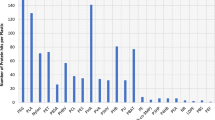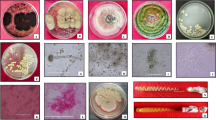Abstract
Jute is one of the most versatile bast fibers obtained through the process of retting, which is a result of decomposition of stalks by the indigenous microflora. However, bacterial communities associated with the retting of jute are not well characterized. To investigate the presence of microorganisms during the process of jute retting, full-cycle rRNA approach was followed, and two 16S rRNA gene libraries, from jute-retting locations of Krishnanagar and Barrackpore, were constructed. Phylotypes affiliating to seven bacterial divisions were identified in both libraries. The bulk of clones came from Proteobacteria (∼37, 41%) and a comparatively smaller proportion of clones from the divisions—Firmicutes (∼11, 12%), Cytophaga–Flexibacter–Bacteroidetes group (CFB; ∼9, 7%), Verrucomicrobia (∼6, 5%), Acidobacteria (∼4, 5%), Chlorobiales (∼5, 5%), and Actinobacteria (∼4, 2%) were identified. Percent coverage value and diversity estimations of phylotype richness, Shannon–Weiner index, and evenness confirmed the diverse nature of both the libraries. Evaluation of the retting waters by whole cell rRNA-targeted flourescent in situ hybridization, as detected by domain- and group-specific probes, we observed a considerable dominance of the beta-Proteobacteria (25.9%) along with the CFB group (24.4%). In addition, 32 bacterial species were isolated on culture media from the two retting environments and identified by 16S rDNA analysis, confirming the presence of phyla, Proteobacteria (∼47%), Firmicutes (∼22%), CFB group (∼19%), and Actinobacteria (∼13%) in the retting niche. Thus, our study presents the first quantification of the dominant and diverse bacterial phylotypes in the retting ponds, which will further help in improving the retting efficiency, and hence the fiber quality.






Similar content being viewed by others
References
Ahmed Z, Akhter F (2001) Jute retting: An overview. Online J Biol Sci 1:685–688
Altschul S, Gish W, Miller E, Lipman D (1990) Basic local alignment search tool. J Mol Biol 215:403–410
Amann R, Glöckner F, Neef A (1997) Modern methods in subsurface microbiology: in situ identification of microorganisms with nucleic acid probes. FEMS Micobiol Rev 20:191–200
Amann R, Ludwig W (2000) Ribosomal RNA-targeted nucleic acid probes for studies in microbial ecology. FEMS Microbiol Rev 24:555–565
Amann RI, Krumholz L, Stahl DA (1990) Fluorescent-oligonucleotides probing of whole cells for determinative, phylogenetic and environmental studies in microbiology. J Bacteriol 172:762–770
Bramucci M, Kane H, Chen M, Nagarajan V (2003) Bacterial diversity in an industrial wastewater bioreactor. Appl Microbiol Biotech 62(5–6):594–600
Brosius J, Dull TJ, Sleeter DD, Noller HF (1981) Gene organization and primary structure of a ribosomal RNA operon from Escherichia coli. J Mol Biol 148:107–127
Chandler DP, Li S, Spadoni CM, Drake GR, Balkwill DL, Fredrickson JK, Brockman FJ (1997) A molecular comparison of culturable aerobic heterotrophic bacteria and 16S rDNA clones derived from a deep subsurface sediment. FEMS Microbiol Ecol 23:131–144
Chin K-J, Hahn D, Hengstmann U, Liesack W, Janssen PH (1999) Characterization and identification of numerically abundant culturable bacteria from the anoxic bulk soil of rice paddy microcosms. Appl Environ Microbiol 65:5042–5049
Chin K-J, Rainey FA, Janssen PH, Conrad R (1998) Methanogenic degradation of polysaccharides and characterization of polysaccharolytic clostridia from anoxic rice field soil. Syst Appl Microbiol 21:185–200
Chin K-J, Liesack W, Janssen PH (2001) Opitutus terrae gen. nov., sp. nov., to accommodate novel strains of the division ‘Verrucomicrobia’ isolated from rice paddy soil. Int J Syst Evol Microbiol 51:1965–1968
Cole JR, Chai B, Farris RJ, Wang Q, Kulam SA, McGarrell DM, Garrity GM, Tiedje JM (2005) The Ribosomal Database Project (RDP-II): sequences and tools for high-throughput rRNA analysis. Nucleic Acids Res 33:D294–D296 (database issue)
Cottrell MT, Kirchman DL (2000) Community composition of marine bacterioplankton determined by 16S rRNA gene clone libraries and fluorescence in situ hybridization. Appl Environ Microbiol 66:5116–5122
Curtis TP, Sloan WT (2004) Prokaryotic diversity and its limits: microbial community structure in nature and implications for microbial ecology. Curr Opin Microbiol 7:221–226
Daims H, Brühl A, Amann R, Schleifer K-H, Wagner M (1999) The domain-specific probe EUB338 is insufficient for the detection of all Bacteria: development and evaluation of a more comprehensive probe set. Syst Appl Microbiol 22:434–444
Dang H, Lovell CR (2000) Bacterial primary colonization and early succession on surfaces in marine waters as determined by amplified rRNA gene restriction analysis and sequence analysis of 16S rRNA genes. Appl Environ Microbiol 66:467–475
Dunbar J, Takala S, Barns SM, Davis JA, Kuske CR (1999) Levels of bacterial community diversity in four arid soils compared by cultivation and 16S rRNA gene cloning. Appl Environ Microbiol 66:1662–1669
Ellis RJ, Morgan P, Weightman AJ, Fry JC (2003) Cultivation-dependent and -independent approaches for determining bacterial diversity in heavy-metal-contaminated soil. Appl Environ Microbiol 69:3223–3230
Felske A, Wolterink A, van Lis R, de Vos WM, Akkermans ADL (1999) Searching for predominant soil bacteria: 16S rDNA cloning versus strain cultivation. FEMS Microbiol Ecol 30:137–145
Forsberg CW, Beveridge TJ, Hellstrom A (1981) Cellulase and xylanase release from Bacteroides succinogenes and its importance in the rumen environment. Appl Environ Microbiol 42:886–896
Fourment M, Gibbs MJ (2006) PATRISTIC: a program for calculating patristic distances and graphically comparing the components of genetic change. BMC Evol Biol 6:1–5
Glöckner FO, Fuchs B, Amann R (1999) Bacterioplankton compositions of lakes and oceans: a first comparison based on fluorescence in situ hybridization. Appl Environ Microbiol 65:3721–3726
Hugenholtz P, Goebel BM, Pace NR (1998) Impact of culture-independent studies on the emerging phylogenetic view of bacterial diversity. J Bacteriol 180:4765–4774
Hughes JB, Hellmann JJ, Ricketts TH, Bohannan BJM (2001) Counting the uncountable: statistical approaches to estimating microbial diversity. Appl Environ Microbiol 67:4399–4406
Janssen PH (2006) Identifying the dominant soil bacterial taxa in libraries of 16S rRNA and 16S rRNA genes. Appl Environ Microbiol 72(3):1719–1728
Jarman CG (1985) The retting of Jute. FAO Agriculture Organization of the United Nations, Via delle Terme di Caracalla, Rome, Italy, pp 1–54
Jukes TH, Cantor CR (1969) Evolution of protein molecules. In: Munro HN (ed) Mammalian Protein Metabolism. Academic, New York, NY, USA, pp 21–132
Juretschko S, Loy A, Lehner A, Wagner M (2002) The microbial community composition of a nitrifying-denitrifying activated sludge from an industrial sewage treatment plant analyzed by the full-cycle rRNA approach. Syst Appl Microbiol 25:84–99
Kim KS, Lilburn TG, Renner MJ, Breznak JA (1998) arfI and arfII, two genes encoding α-L-arabinofuranosidases in Cytophaga xylanolytica. Appl Environ Microbiol 64:1919–1923
Kirchman DL (2001) The ecology of Cytophaga–Flavobacteria in aquatic environments. FEMS Microbiol Ecol 39:91–100
Loy A, Lehner A, Lee N, Adamczyk J, Meier H, Ernst J, Schleifer K-H, Wagner M (2002) Oligonucleotide microarray for 16S rRNA gene-based detection of all recognized lineages of sulfate-reducing prokaryotes in the environment. Appl Environ Microbiol 68:5064–5081
Mandal TC, Saha MN (1997) Retting. In: Jute retting method and mechanisation. Central Research Institute for Jute and Allied Fibres, Barrackpore, West Bengal, India, pp 13–61
Manz W, Amann R, Ludwig W, Vancanneyt M, Schleifer K-H (1996) Application of a suite of 16S rRNA-specific oligonucleotide probes designed to investigate bacteria of the phylum cytophaga-flavobacter-bacteroides in the natural environment. Microbiology 142:1097–1106
Manz W, Amann R, Ludwig W, Wagner M, Schleifer K-H (1992) Phylogenetic oligodeoxynucleotide probes for the major subclasses of Proteobacteria: problems and solutions. Syst Appl Microbiol 15:593–600
Neef A (1997) Anwendung der in situ Einzelzell-Identifizierung von Bakterien zur Populationsanalyse in komplexen mikrobiellen Biozönosen. Doctoral thesis, Technische Universität München
O’Farrell KA, Janssen PH (1999) Detection of Verrucomicrobia in a pasture soil by PCR-mediated amplification of 16S rRNA genes. Appl Environ Microbiol 65:4280–4284
Page F, Altabe S, Hugouvieux-Cotte-Pattat N, Lacroix J-M, Robert-Baudouy J, Bohin J-P (2001) Osmoregulated periplasmic glucan synthesis is required for Erwinia chrysanthemi pathogenicity. J Bacteriol 183:3134–3141
Rohlf FJ (1993) NTSYS-PC: Numerical Taxonomy and Multivariate Analysis System—version 2.0. Exeter Software, New York
Rosemberg JA (1965) Bacteria responsible for the retting of Brazilian flax. Appl Microbiol 13:991–992
Saitou N, Nei M (1987) The neighbor-joining method: a new method for reconstructing phylogenetic trees. Mol Biol Evol 4:406–425
Sanno A, Tas J-P, Pippola S, Lindstrom K, van Elsas JD (1995) Extraction and analysis of microbial DNA from soil. In: Trevor JT, vanElsaas JD (eds) Nucleic Acid in the Environment—Methods and Applications. Springer, Berlin, Germany, pp 179–218
Sharma HSS, Lefevre J, Boucaud J (1992) Role of microbial enzymes during retting and their effect on fibre characteristics. In: Sharma HSS, Van Sumere SF (eds) The Biology and Processing of Flax. M Publications, Belfast, Northern Ireland, pp 199–212
Smit E, Leeflang P, Gommans S, van den Broek J, van Mil S, Wernars K (2001) Diversity and seasonal fluctuations of the dominant members of the bacterial soil community in a wheat field as determined by cultivation and molecular methods. Appl Environ Microbiol 67:2284–2291
Suzuki MT, Rappe MS, Haimberger ZW, Winfield H, Adair N, Strobel J, Giovannoni SJ (1997) Bacterial diversity among small-subunit rRNA gene clones and cellular isolates from the same seawater samples. Appl Environ Microbiol 63:983–989
Thompson JD, Gibson TJ, Plewniak F, Jeanmougin F, Higgins DG (1997) The ClustalX windows interface: flexible strategies for multiple sequence alignment aided by quality analysis tools. Nucleic Acids Res 25:4876–4882
Van Sumere C, Sharma H (1991) Analysis of fine flax fibre produced by enzymatic retting. Aspects Appl Biol 28:15–20
von Wintzingerode F, Göbel UB, Stackebrandt E (1997) Determination of microbial diversity in environmental samples: pitfalls of PCR-based rRNA analysis. FEMS Microbiol Rev 21:213–229
Warnecke F, Amann R, Pernthaler A (2004) Actinobacterial 16S rRNA genes from freshwater habitats cluster in four distinct lineages. Environ Microbiol 6:242–253
Weber S, Stubner S, Conrad R (2001) Bacterial populations colonizing and degrading rice straw in anoxic paddy soil. Appl Environ Microbiol 67:1318–1327
Zwart G, Crump BC, Agterveld MP, Hagen F, Han SK (2002) Typical freshwater bacteria: an analysis of available 16S rRNA gene sequences from plankton of lakes and rivers. Aquat Microb Ecol 28:141–155
Zwisler W, Selje N, Simon M (2003) Seasonal patterns of the bacterioplankton community composition in a large mesotrophic lake. Aquat Microb Ecol 31:211–225
Acknowledgements
This project was funded by the grants from Department of Biotechnology, Ministry of Science and Technology, Government of India. The authors would like to thank Prof. Nirmalendu Samajpati, Botany Department, Calcutta University, Kolkata, West Bengal, India, for his help during collection of jute stems and retting water samples from West Bengal, India.
Author information
Authors and Affiliations
Corresponding author
Rights and permissions
About this article
Cite this article
Munshi, T.K., Chattoo, B.B. Bacterial Population Structure of the Jute-Retting Environment. Microb Ecol 56, 270–282 (2008). https://doi.org/10.1007/s00248-007-9345-8
Received:
Revised:
Accepted:
Published:
Issue Date:
DOI: https://doi.org/10.1007/s00248-007-9345-8




